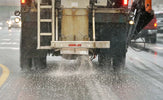
How to Remove Road Salt from Your Vehicle
, by Mia Beewen, 9 min reading time

, by Mia Beewen, 9 min reading time
Road salt is a silent killer of cars in winter. Learn how to remove salt safely and why pairing car washes with NHOU rust protection ensures real, long-term defense against corrosion.
Car Wash or Rust Protection Treatment – What Really Protects Your Car?
As a vehicle owner, you want your car to look great and stay solid for the long run. In winter, road salt accelerates corrosion—especially on the underbody, seams, and cavities. Should you rely on frequent car washes, invest in a professional rust protection treatment, or both? This guide explains how to remove salt properly and how NH Oil Undercoating (NHOU) adds the lasting protection washes alone can’t provide.
De-icing agents like sodium chloride, magnesium chloride, and calcium chloride dissolve into electrolytes that speed up the corrosion process. Moisture plus oxygen plus salt creates the perfect environment for rust. The undercarriage, brake and fuel lines, subframes, suspension components, seams, and hidden cavities are most vulnerable.
A car wash is the obvious choice for the vehicle’s exterior. It removes dirt, loose salt residue, insects, and other contaminants.
It’s a common misconception that frequent washing automatically prevents rust. Washing helps remove grime and loose salt, but modern de-icers such as magnesium chloride adhere strongly to the undercarriage and can’t always be fully rinsed away—especially from seams and hidden crevices.
Important: Many car washes recycle water for sustainability. Recycled water systems are not primarily designed to remove dissolved salts, so small residues can remain on surfaces after a quick pass.
↑ Back to topFor long-term corrosion control—especially underneath—professional rust protection is essential. NH Oil Undercoating (NHOU) is a fluid, self-healing treatment that creeps into seams, overlaps, and inaccessible areas where corrosion starts. It displaces moisture, seals out salt, and forms a durable protective film.
Apply NHOU once a year, ideally before winter. Reapply to high-spray zones (wheel arches, rocker panels) as needed if you drive in heavy salt conditions.
Use this safe, repeatable process when your car has visible salt deposits or after driving through brine.
Salt on floor mats? Dissolve with warm water and a small amount of fabric-safe cleaner. Blot—don’t scrub—then extract and dry thoroughly.
↑ Back to topYou don’t have to choose—combine both for the best outcome.
| Car Wash | Rust Protection Treatment (NHOU) |
|---|---|
| Removes surface dirt and loose salt | Specifically protects the underbody and cavities |
| Improves outward appearance and visibility | Prevents long-term rust formation |
| Requires regular maintenance | Recommended once a year |
| Great for paint, glass, and trim | Great for subframes, seams, welds, and hidden pockets |
NHOU leaves a protective film that creeps and self-levels, helping to seal seams and displace moisture over time.
Washing helps, but it’s not a full solution. Brine and moisture can remain in seams and cavities. A dedicated rust protection like NHOU is designed to protect those areas long-term.
NHOU is a fluid film treatment applied by trained technicians who avoid sensitive components. Always follow manufacturer guidance for high-voltage systems and connectors.
Typically one year in harsh winter climates, with touch-ups to high-spray areas as needed. Annual inspections are recommended.
Some light drip-off shortly after application is normal. Shops use controlled techniques and masking to keep overspray to a minimum.
DIY is possible with the right tools and access, but professional application ensures thorough cavity coverage and proper prep for best results.
A clean exterior matters—but real protection starts beneath the surface. Regular washes remove grime and loose salt, while NHOU rust protection blocks moisture and salt where corrosion begins. Together, they help preserve value, improve safety, and reduce repair costs—season after season.
Book an NHOU rust protection treatment or a free underbody inspection today.